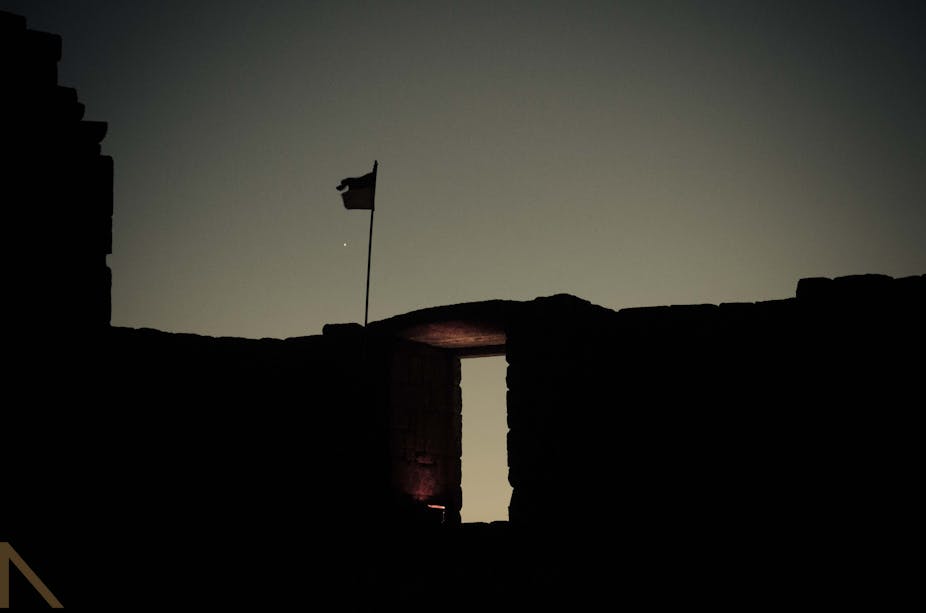According to Hansard, in the parliament of John Howard’s first term of government the adjective “medieval” was used eight times. In the following term, however, it cropped up 46 times. What happened? Why did our members and senators suddenly need to describe things as medieval?
What happened was 9/11. The spectacle of planes crashing into skyscrapers prompted myriad politicians, in Australia and elsewhere, to denounce the perpetrators as “medieval”.
Right now, “medieval” is spiking again. In response to the footage of the beheading of James Foley, Prime Minister Tony Abbott declared in parliament:
What we have seen in recent weeks is medieval barbarism, perpetrated and spread with the most modern of technology.
Abbott is not alone; it has become commonplace to describe Islamic State (IS, formerly ISIS or ISIL) as a brutal throwback to a murky violent past called, interchangeably, the Dark Ages and the Middle Ages. Why the Middle Ages? Why now?
Historians of the Middle Ages will tell you that al-Qaeda and IS bear little resemblance, in their words or deeds, to actual medieval people. The religious fundamentalism that characterises al-Qaeda and IS, for example, is a relatively recent phenomenon. Broadcasting choreographed violent spectacles as a means of creating shock and fear owes its strategy more to Hollywood and viral media than it does to the Middle Ages.
So why read Islamic terror as medieval?
The answer lies in the longer history of the idea of the Middle Ages as the convenient other to modernity in the Western cultural imagination. First deployed in the Renaissance, the term “medieval” was invented by scholars who wanted to celebrate the progress of their own age in contrast to the preceding centuries. Describing something as medieval has since endured as a successful form of negative branding.
Since the Renaissance, whenever modernity has found itself in crisis - when the shibboleths of rationalism, secularism, capitalism and the nation-state seem to be coming apart at the seams – fantasies of the medieval have suggested a mostly frightening, though sometimes alluring, vision of what the alternatives to modernity might be.
What are these cultural fantasies? The neo-medieval world of Game of Thrones suggests a few of them, with the evident pleasure it takes in its trinity of sex, violence and chivalry. Life in the seven kingdoms is cheap. People are heroes or villains, honourable or tyrannical, noble or base.
This is not a world governed by the rule of law, of constitutionality, or of the nation-state. This is the place where, ultimately, both tribal affiliation and supernatural irrationality reign. Hence the dragons.
When commentators and politicians describe Islamic State as “medieval” they are placing the organisation opportunely outside of modernity, in a sphere of irrationality. The point being made is that they are people from a barbaric and superstitious past, and consequently have not matured into modern political actors. Medievalising IS supporters puts them a very long way away from the here and, even more pointedly, from the now.
The post-9/11 usage of “medieval” to describe Islamist terrorism tells us as much about vocabularies within Western political thought as it does about the ideologies of al-Qaeda and IS. Edward Said devoted his very famous book Orientalism to describing the Western penchant for imagining the East as outside of history, and as erotic and oppressive in the same instance.
Medievalism, as the scholar John Ganim has pointed out, functions in very similar ways to orientalism, and often in tandem. It reduces the Other to unknowability, and yet makes it exotic, bewitching and, ultimately, dangerous.
Why does this matter?
Recent political history tells us that the stakes of this conversation are very high indeed. After 9/11, the infamous Torture Memos produced out of the office of the then US attorney-general Alberto Gonzales insistently labelled al-Qaeda and the Taliban as feudal and tribal.
The point, in doing so, was to argue that since they worked within medieval non-national structures they could be categorised as non-state combatants. This meant that they did not need to be accorded the rights granted to prisoners of war under the Geneva Convention. Medievalising al-Qaeda and the Taliban was a crucial part of the legal strategy that led to Guantanamo Bay.
Lest this seem a Western practice only, IS, for their part, are participating wholeheartedly in their own medievalist script in their declaration of a new Caliphate. Their notion of a glorious fundamentalist Islamic Middle Age is also a fantasy. It bears little relationship to the historical record of the very complicated and diverse forms of Islamic governance that evolved in the Middle East and around the Mediterranean. The IS desire for statehood is a decisively modern one, which has its origins as much in the 1648 Treaty of Westphalia as it does in the history of Islam.
All of this is to say that when politicians, commentators and indeed terrorists try to get political mileage from using the term “medieval” they should understand that this idea does not align with historical fact. Instead, it is an idea that bears and perpetuates an ideology of othering.
Whether it is US Secretary of State John Kerry describing the beheading of Stephen Sotloff as “an act of medieval savagery”, or IS leader Abu Bakr al Baghdadi being declared by his followers as the “Caliph of all Muslims and the Prince of the Believers”, in both cases we see fantasies of the medieval being used as a shorthand to describe what is not modern or Western. It seems that it is almost impossible to think about postmodern futures without recruiting the medieval past.

